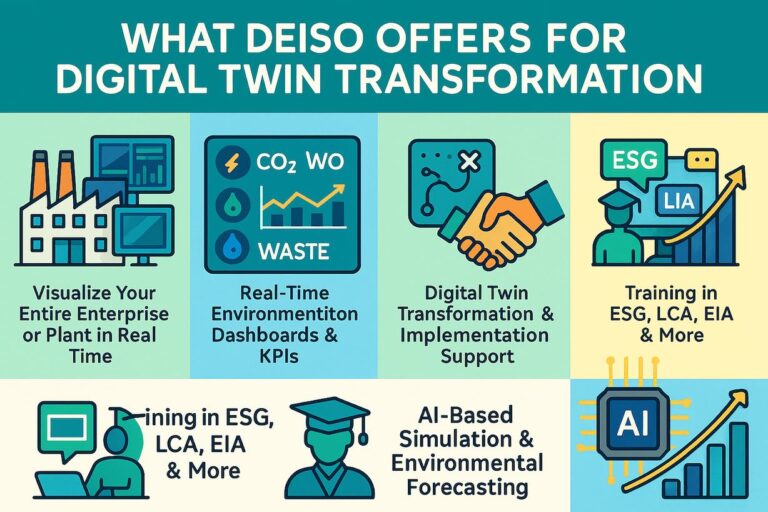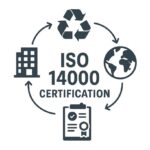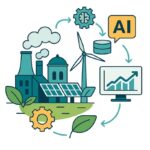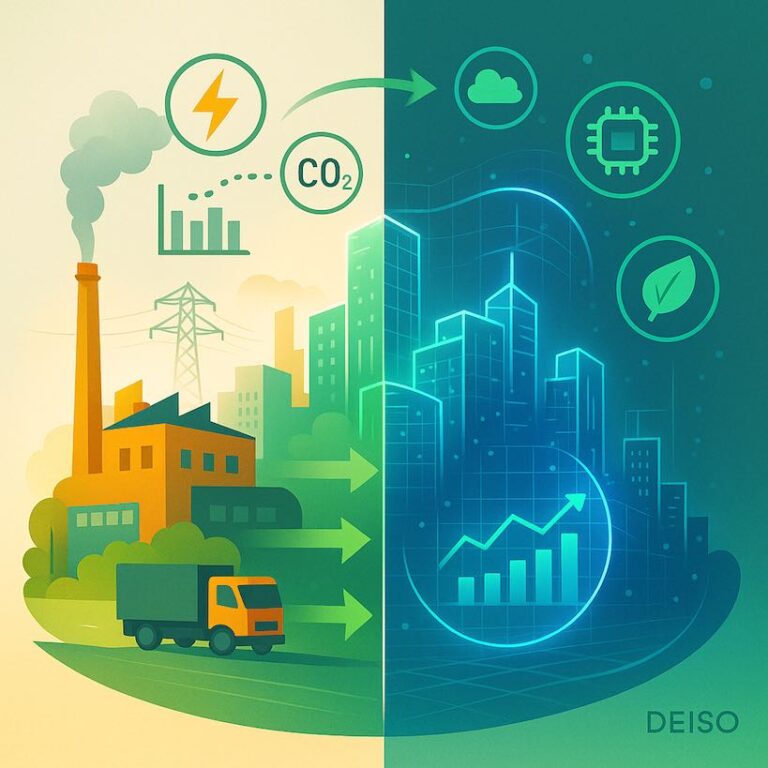
Section 1: Introduction – The Dawn of Sustainable Digital Transformation
In an era marked by growing climate concerns and stringent environmental regulations, businesses are under more pressure than ever to prove their sustainability credentials. Traditional approaches to environmental management — spreadsheets, annual reports, and manual assessments — are no longer enough to meet the demands of regulators, investors, and environmentally conscious consumers.
This is where digital twins step into the spotlight. Once a niche technology used primarily in aerospace and industrial engineering, digital twins have evolved into one of the most powerful tools for environmental intelligence. Simply put, a digital twin is a dynamic, virtual representation of a real-world object or system that updates based on actual data in real time.
But when applied through a sustainability lens, this concept becomes transformative. Digital twins allow companies to continuously monitor, model, and optimize their environmental performance across facilities, assets, and supply chains, unlocking the ability to reduce impact proactively rather than just report it reactively.
This blog post explores how digital twins for sustainability are reshaping how organizations think about environmental performance — and how DEISO is helping businesses lead this transition from simulation to real-time, data-driven impact reduction.
Section 2: What Exactly is a Digital Twin in the Context of Sustainability?
A digital twin is a real-time, virtual replica of a physical asset, system, or environment. It integrates live data streams, historical performance records, and predictive models to simulate real-world behavior dynamically. Unlike traditional simulations, which are static and disconnected from operations, digital twins evolve alongside their physical counterparts.
In the context of sustainability, this means businesses can create intelligent digital models of their:
Factories and production lines
Buildings and infrastructure
Supply chains and logistics networks
These models don’t just involve operations — they embed environmental data like:
Energy use
Greenhouse gas emissions
Water consumption
Waste output
Material flows
A digital twin for sustainability acts as a “living environmental dashboard”, allowing b”businesses to:
Track real-time impact across systems and geographies
Simulate future environmental outcomes
Test “what-if” strategies without the cost or risk of physical experimentation
By weaving together operational data with environmental science, digital twins transform how companies manage their ecological footprint. It is no longer just about understanding what has happened — but continuously shaping what could happen for the better.

Section 3: Beyond Compliance – Why Digital Twins Are the Future of ESG and Impact Reduction
Traditional environmental assessments have long been the norm: periodic reports, spreadsheets, and delayed insights based on historical data. While these tools serve compliance requirements, they rarely enable proactive environmental performance management. They show what has happened, but not what is happening now, let alone what could happen next.
Digital twins change this equation. By connecting real-time operational data with simulation and predictive modeling, digital twins empower organizations to:
Monitor environmental KPIs continuously
No more waiting for monthly or quarterly reports. Digital twins deliver real-time dashboards of emissions, water use, energy consumption, and more.Predict environmental impact
Using AI and scenario modeling, digital twins can forecast the consequences of decisions, such as switching materials, altering production rates, or changing transportation routes.Simulate what-if scenarios
What if we reduce our energy intensity by 10%? What if we localize part of the supply chain? Digital twins help companies answer these questions before implementing changes.Move from reactive to proactive.
Rather than scrambling to mitigate environmental risks after the fact, companies can now anticipate and avoid the risks associated with aligning ecological and financial performance.
This real-time intelligence is also revolutionizing ESG reporting. With digital twins, companies can provide stakeholders with up-to-date, credible, and auditable environmental performance data, building transparency and trust.
Digital twins aren’t just a new sustainability tool. They’re a new paradigm — enabling a more responsive, intelligent, and future-ready approach to environmental impact reduction.
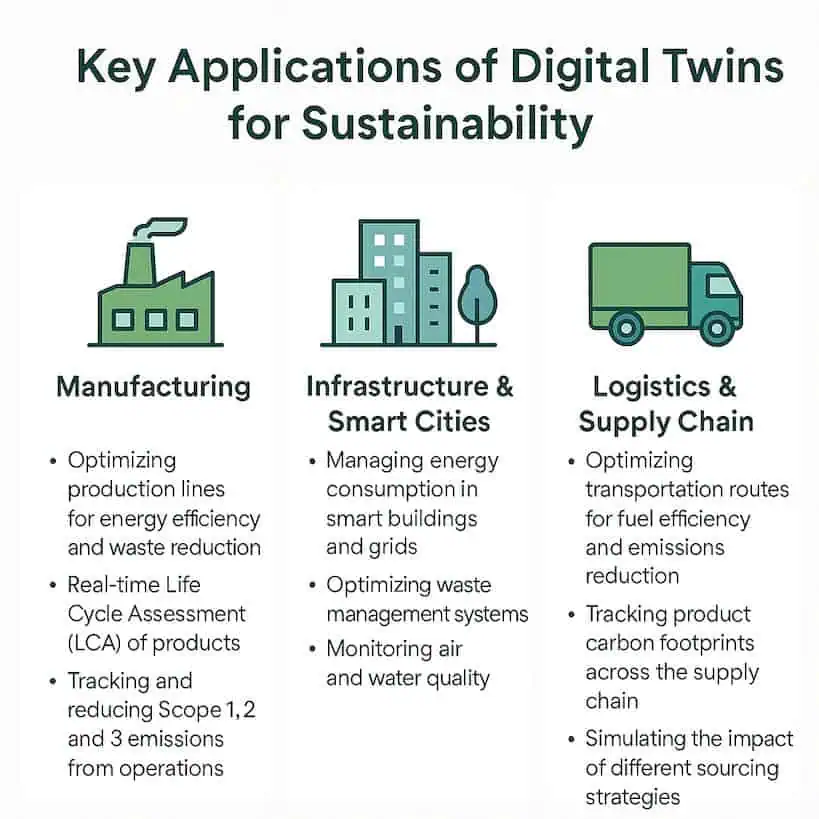
4: Key Applications – Where Digital Twins Make a Real Difference in Sustainability
Digital twins are no longer confined to pilot projects or experimental labs; they now deliver measurable environmental benefits across entire industries. By integrating physical operations with real-time data and intelligent simulation, businesses can optimize processes, reduce emissions, and make data-backed sustainability decisions. Here’s how this transformation plays out across key sectors — all areas where DEISO brings deep expertise and tailored solutions:
🏭 Manufacturing
Energy Optimization:
Digital twins enable live energy flow monitoring across machines and production lines. Factories can identify and eliminate inefficiencies in real time.Real-time Life Cycle Assessment (LCA):
With DEISO’s advanced LCA modeling, digital twins continuously update a product’s environmental footprint throughout its development and use, reducing manual data collection and improving precision.Emissions Tracking (Scope 1, 2, 3):
From on-site fuel combustion (Scope 1) to purchased electricity (Scope 2) and supply chain impacts (Scope 3), digital twins help track emissions holistically.
🏙️ Infrastructure & Smart Cities
Building Performance:
Digital twins of buildings simulate HVAC usage, lighting, and occupancy to minimize energy consumption while maintaining comfort.Waste Management Optimization:
Municipalities use digital twins to model and streamline waste collection routes, recycling efficiency, and landfill diversion rates.Environmental Monitoring:
Sensors connected to digital twins track air quality, noise pollution, and water health across urban systems, enabling informed environmental policymaking.
🚚 Logistics & Supply Chain
Route Optimization:
Digital twins of logistics networks optimize fuel efficiency delivery paths, reducing cost and emissions.Carbon Footprint Tracking:
DEISO helps clients integrate carbon tracking into their supply chain twins, enabling full visibility of emissions from raw materials to end-of-life.Sustainable Sourcing Simulations:
Businesses can test the environmental trade-offs of different sourcing strategies (local vs. global, recycled vs. virgin materials).
Digital twins allow these industries to see their environmental impact before it happens and act decisively. With DEISO’s support, organizations turn digital insight into tangible, sustainable outcomes — from reduced emissions to smarter investments in green innovation.
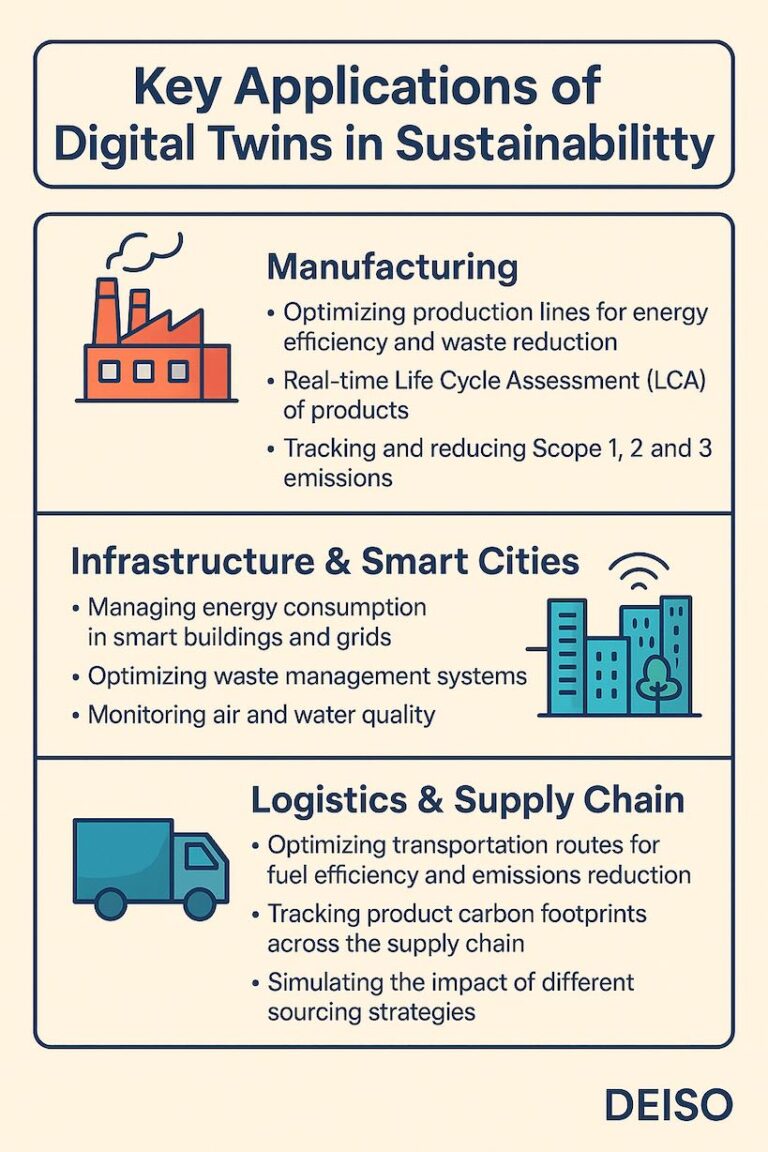
Section 5: DEISO’s Approach to Empowering Your Sustainable Digital Twin Journey
While the concept of digital twins is powerful, implementing them effectively for sustainability requires more than just technology. It demands a partner who understands both the complexities of environmental impact and the capabilities of digital systems. That’s where DEISO comes in.
🧠 DEISO Consultancy Services
We begin with deep consultation to:
Identify your organization’s most critical environmental challenges.
Map those challenges to digital twin opportunities.
Develop an actionable plan that balances technical feasibility and environmental benefit.
From material flow to emissions modeling, we tailor strategies to your operational and sustainability objectives.
🛠️ DEISO Digital & AI Products and Services
We design and deploy custom digital twin platforms powered by:
Live environmental data feeds (energy, emissions, water, etc.).
Simulation engines for LCA, GHG forecasting, and carbon footprint tracking.
AI models that optimize performance and recommend sustainability actions.
Whether you’re modeling a production line, an urban grid, or a global supply chain, DEISO ensures the twin aligns with your data, goals, and industry context.
🎓 DEISO Premium Training
Technology is only effective when people can use it. Our training covers:
Practical use of digital twins for LCA, PCF, GHG, and ESG tracking.
Hands-on sessions for analysts, engineers, and decision-makers.
How to interpret and act on digital twin insights to drive impact.
🌍 Why DEISO?
With a proven track record and a multidisciplinary team, DEISO is uniquely equipped to support digital twin journeys across industries. We unite environmental science, data engineering, AI, and corporate strategy to help you transform ambition into action.
In short, DEISO helps you do more than deploy a digital twin — we help you build a sustainability intelligence system that drives measurable, real-time impact.
Section 6: Overcoming Challenges & The Road Ahead
Adopting digital twins for sustainability is not a plug-and-play process. It requires strategic planning, interdisciplinary collaboration, and a long-term commitment to innovation. But the organizations that embrace these challenges are the ones positioning themselves to lead in a data-driven, low-carbon future.
⚠️ Common Challenges Organizations Face
-
Data Fragmentation:
Environmental data often resides across silos — spreadsheets, ERP systems, utility bills, third-party sources — making real-time integration difficult. -
High Initial Investment:
Developing or adopting a digital twin framework can be perceived as expensive, especially for organizations unfamiliar with its long-term value. -
Lack of In-House Expertise:
Many companies don’t yet have the cross-functional teams — blending IT, sustainability, and operations — needed to manage twin technologies effectively. -
Change Resistance:
Organizational inertia and legacy systems can slow down digital transformation efforts, even when leadership is aligned.
✅ How DEISO Helps You Overcome These Hurdles
DEISO’s holistic, hands-on approach ensures you don’t face these challenges alone:
-
We design tailored roadmaps to gradually introduce digital twin capabilities, aligned with your data maturity level and environmental goals.
-
Our team integrates fragmented datasets into a cohesive twin model, using smart connectors, APIs, and AI-powered cleansing.
-
We deliver training and upskilling programs that transform your workforce into confident users of digital twin platforms.
-
Our change management support ensures stakeholder buy-in, adoption, and long-term success.
🔭 The Road Ahead
The future of digital twins in sustainability is dynamic and promising:
-
AI will evolve twins from descriptive to prescriptive systems — not just modeling data, but recommending optimal sustainability actions.
-
IoT and edge computing will enhance real-time insights across even remote, off-grid operations.
-
Sector-specific twin templates will emerge — from agriculture to construction — accelerating adoption and reducing cost barriers.
As environmental pressures rise and ESG expectations intensify, digital twins will become standard infrastructure for any organization serious about impact reduction.
Section 7: Conclusion – Your Next Step Towards Real-Time Impact Reduction
The path to environmental sustainability no longer has to be reactive, delayed, or unclear. With digital twins, organizations gain the power to see, simulate, and strategically improve their environmental performance in real time.
From manufacturing plants to smart cities and supply chains, digital twins are transforming how companies:
Monitor emissions and energy use continuously
Simulate changes before making costly decisions
Integrate sustainability directly into daily operations
And with DEISO’s expertise, this transformation is not only possible — it’s practical, actionable, and measurable.
🎯 Why Take the Next Step with DEISO?
Whether you’re exploring your first sustainability initiative or scaling a complex digital ecosystem, DEISO’s solutions and support ensure that your digital twin delivers real-world environmental value.
We empower organizations to:
Implement cutting-edge digital twin platforms tailored for environmental use
Train internal teams to lead data-driven sustainability programs
Bridge the gap between ESG ambitions and operational performance
✅ Updated Section 7: Conclusion – Your Next Step Towards Real-Time Impact Reduction (Modified CTA)
The shift from reactive environmental compliance to real-time, proactive sustainability intelligence is now within reach — powered by digital twins and led by forward-thinking organizations. Across industries, digital twins are enabling companies to simulate, measure, and optimize their environmental performance with precision and speed.
🎯 Need Help Getting Started?
🔹 Do you need a custom digital twin solution where you can visualize your entire company, factory, enterprise, or plant in real time — with integrated dashboards for emissions, energy, waste, and more?
🔹 Are you looking for expert consultation to guide your digital twin transformation and implementation — tailored to your specific operations and sustainability goals?
🔹 Or do you need professional training to empower your team with the knowledge to support this transition — including ESG, LCA, Environmental Impact Assessment, and other sustainability competencies directly related to successful digital twin adoption?
🤝 DEISO Can Help
DEISO brings together:
A proven track record in digital twin implementation for sustainability
Advanced AI-powered dashboards and modeling tools
Industry-leading training programs designed to enable technical, operational, and sustainability teams
We help you transform ambition into action with a custom roadmap, tailored platforms, and measurable outcomes.
🚀 Let’s Talk
📩 Book your consultation or explore our training programs today:
👉 Contact DEISO or email us at os.ie1751043674d@ofn1751043674i1751043674
